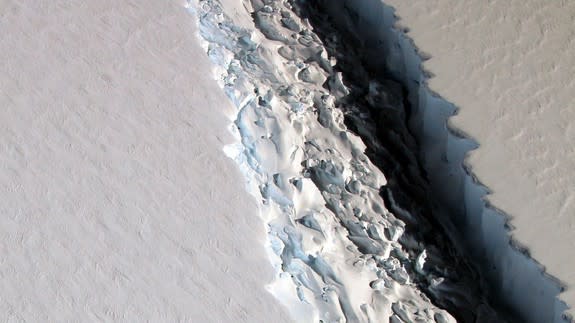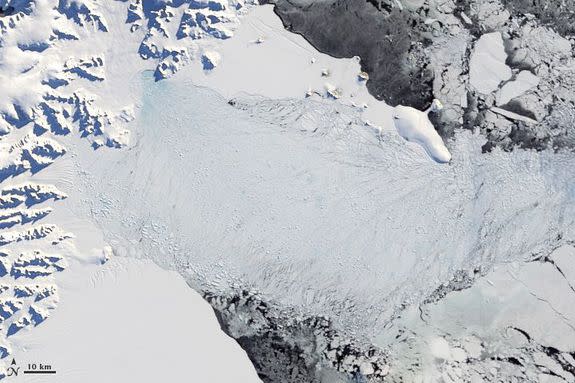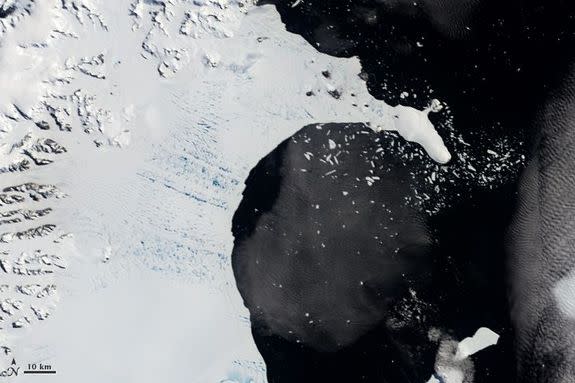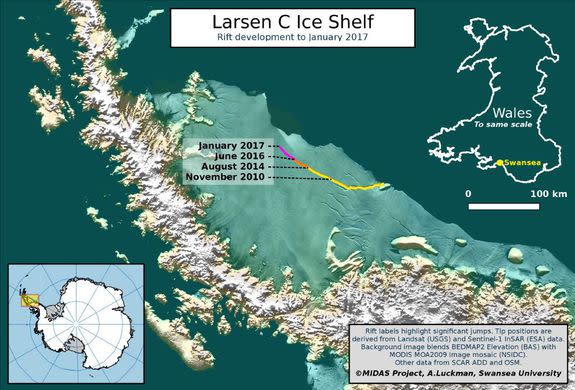An iceberg the size of Delaware is about to break off Antarctica

A partial breakup of the Larsen C ice shelf is imminent, scientists say, resulting in one of the largest icebergs on record—roughly the size of Delaware.
Researchers who closely monitor a crack cutting across the floating Antarctic ice shelf reported on Thursday that its progress had suddenly sped up, indicating that a collapse may soon be underway. If and when it occurs, it could yield one of the top ten largest icebergs on record, possibly in the top three.
More worrisome is the possibility that the calving event—which refers to the breaking off of the iceberg, from the ice shelf that it's now attached to—could speed up the disintegration of the broader ice shelf and land-based ice that lies behind it.
SEE ALSO: NASA photo reveals a startling 300-foot-wide rift in Antarctic Ice Shelf
The area of ice slated to break off the ice-covered continent is more than 1,930 square miles, or greater than than 5,000 square kilometers in area, according to scientists affiliated with Project MIDAS, which monitors the ice shelf with support from the British Antarctic Survey and other partners.
The researchers found that the rift that had been steadily progressing across the floating ice shelf suddenly grew by 11.2 miles, or 18 kilometers, during the second half of December. This leaves only 12.4 miles, or 20 kilometers, of ice left connecting the iceberg to its parent ice shelf.
"We expect that the iceberg will break free within the next few months, although it's hard to be certain about timing," said Martin O'Leary, a researcher at Swansea University in the U.K. who studies the Larsen C Ice Shelf as part of the MIDAS team, in an email to Mashable.
Rifts like this are a natural phenomenon, and we're not aware of any direct link to climate change. This is simply the natural way in which ice is removed from the shelf. That said, events like this are rare (last one on Larsen C was in the mid-80s), so we don't really have enough observations to say for certain whether there's a climate link or not.
View is of a rift in the Antarctic Peninsula's Larsen C ice shelf from our airborne survey of polar ice: https://t.co/VgjxopHHLI @NASA_ICE pic.twitter.com/gt5mpHqbxn
— NASA (@NASA) December 3, 2016
The iceberg calving event, which is an extreme example of a typical process in the Antarctic and Arctic, may weaken the larger ice shelf and speed its total disintegration. This has been happening in parts of the West Antarctic Ice Sheet, but it is not guaranteed to happen with Larsen C.
The Larsen C Ice Shelf is the most northerly of the remaining major Antarctic Peninsula ice shelves. This part of Antarctica has been warming rapidly in recent years, and the shelf is being undermined from below by warming ocean waters, as well as from above by increasing air temperatures.
In 2002, Larsen C's neighbor, known as the Larsen B Ice Shelf, disintegrated entirely after a series of similar rift-induced calving events. The Larsen B calving event was featured in the opening scenes of the sci-fi climate change-related disaster film, The Day After Tomorrow.

Image: nasa

Image: nasa
The researchers from the MIDAS project predict that Larsen C may ultimately meet the same fate as its neighbor, since the upcoming calving event will leave the ice shelf in a less stable position.
"When it calves, the Larsen C Ice Shelf will lose more than 10 percent of its area to leave the ice front at its most retreated position ever recorded: this event will fundamentally change the landscape of the Antarctic Peninsula," the scientists wrote in a blog post.

Image: project midas
Obviously, given the collapse of Larsen B, any large change to Larsen C is something we want to watch closely," O'Leary said.
"It's certainly the case that a large enough iceberg calving could destabilize the shelf. We're not sure if this berg is big enough - we think probably not, but there are large uncertainties here," he said. "Certainly it would leave the ice shelf in a more vulnerable state."
In December, NASA released an astonishing new image taken by researchers flying above the Larsen C Ice Shelf on Nov. 10 showing the crack was growing longer, deeper and wider.
The scientists associated with a NASA field campaign known as Operation IceBridge, measured the Larsen C fracture at that time to be about 70 miles long, more than 300 feet wide and about a third of a mile deep.
Dan McGrath, a research scientist at Colorado State University who studies Larsen C separately from the MIDAS team, said the rift has proceeded in fits and starts, making the timing of a calving event difficult to predict.
"An "imminent" calving is certainly plausible but highly uncertain," he said. "The rift growth over the past few years has been highly episodic — growing rapidly while crossing sections of the ice shelf sourced from glaciers on the peninsula, while creeping slowly through suture zones, regions of material heterogeneity in the ice shelf," he said in an email to Mashable.
McGrath agreed with the MIDAS team that the ice shelf will be in a more vulnerable state after the calving event.
"...Just how vulnerable is a question we're actively seeking to answer," he said.
Sea level implications
Ice shelves breaking off into icebergs don't directly increase sea levels, since their ice is already resting in the ocean like an ice cube in a glass.
However, because they act like doorstops to the land-based ice behind them, when the shelves give way, the glaciers can start sliding into the sea in a process that's difficult (if not impossible) to stop, long-term. It adds new water to the ocean—therefore, increasing sea levels.
The entire West Antarctic Ice Sheet contains enough ice to raise global sea levels by another 10 to 15 feet if it were all to melt. This process would likely take centuries, however, though sea level rise is already accelerating worldwide as glaciers melt and ocean temperatures increase.
